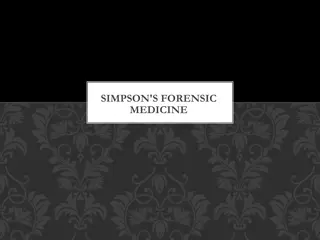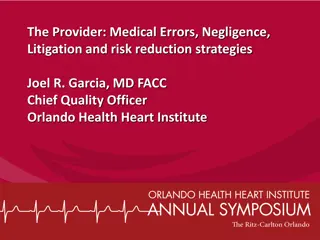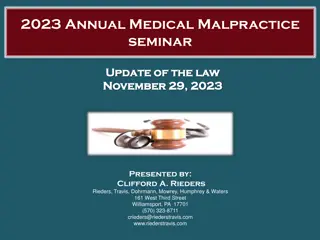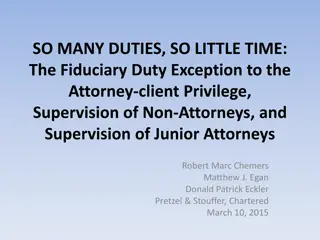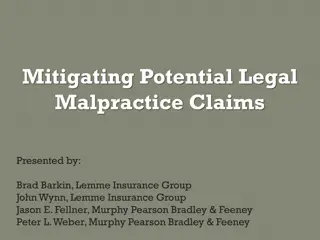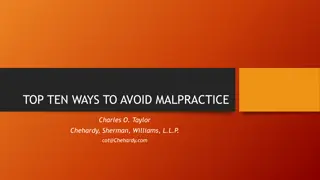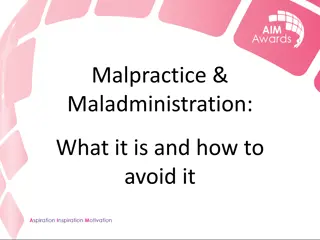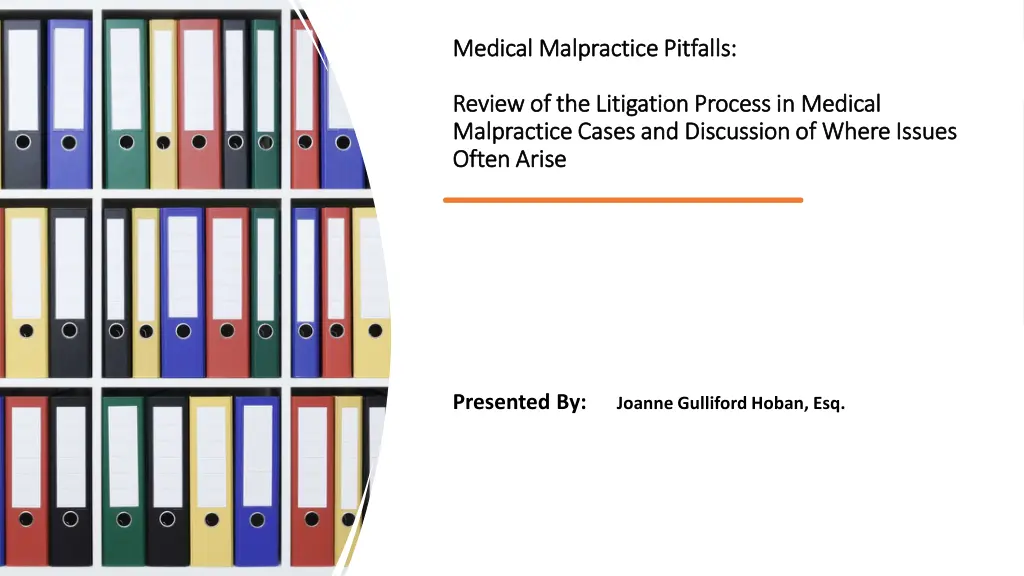
Understanding the Medical Malpractice Litigation Process
Explore the litigation process in medical malpractice cases, including key issues and preventive measures. Learn about initiating claims, provider responses, insurer involvement, and defense strategies. Gain insights to enhance communication, documentation, and patient care.
Download Presentation

Please find below an Image/Link to download the presentation.
The content on the website is provided AS IS for your information and personal use only. It may not be sold, licensed, or shared on other websites without obtaining consent from the author. If you encounter any issues during the download, it is possible that the publisher has removed the file from their server.
You are allowed to download the files provided on this website for personal or commercial use, subject to the condition that they are used lawfully. All files are the property of their respective owners.
The content on the website is provided AS IS for your information and personal use only. It may not be sold, licensed, or shared on other websites without obtaining consent from the author.
E N D
Presentation Transcript
Medical Malpractice Pitfalls: Medical Malpractice Pitfalls: Review of the Litigation Process in Medical Review of the Litigation Process in Medical Malpractice Cases and Discussion of Where Issues Malpractice Cases and Discussion of Where Issues Often Arise Often Arise Presented By: Joanne Gulliford Hoban, Esq.
Disclosure Statements Disclosure Statements This educational presenter has indicated she has no bias or relevant financial relationships. This presentation is not intended to provide legal advice on the topic. Attendees are encouraged to review individual issues/concerns with their General Counsel and/or other legal representatives. This presenter is not making this presentation in any official capacity and is appearing in her individual capacity only.
OBJECTIVES Develop a general understanding of the litigation process and the role the provider/defendant plays in the case and the process. Discussion of thorough documentation and detailed (and documented) informed consent discussions. Review the importance of communication between providers and patients. Review specific case examples and identify ways to proactively prevent issues/avoid surprises during the litigation. Brief review of pending medical malpractice matters/examples of claims that become lawsuits. Questions/Discussion
The Initiation of the Process Claim written or oral demand for compensation for injuries. It may be directed to physician or hospital. Service of a Summons & Complaint (lawsuit) formal legal filing within the court.
Physician Response Upon receipt of a claim, suit or deposition notice: Notification of Claims Management Office or Liability Insurer Follow instructions of the claims staff Limit discussions concerning event Preserve medical records and other evidence
The Insurer Response Retention of counsel to provide defense for defendant physician Interviews of defendants and witnesses to care events Claims investigated by insurance claims staff Management of financial aspects of claim including reserving, expense payments and settlement payment if necessary Development of defense strategies and retention of expert witnesses / Assess liability
Answering of complaint within twenty days of service Asserting the appropriate legal defenses The Legal Response Requesting of the Medical Malpractice Tribunal Obtaining of pertinent records Coordination of physician interviews with claim staff
Negligence To be liable to a patient under a negligence theory, a doctor must breach a duty owed to that patient and that breach must be the legal (proximate) cause of the patient s injury Theories of Liability
Theories of Liability Duty: A doctor must exercise that same degree of skill and care as is exercised by the average qualified practitioner in their field, taking into account the advances in the profession Breach: A deviation from the accepted standard of care Causation: Even when a doctor breaches the above duty owed to a patient, no liability exists unless the plaintiff can establish a causal connection between the doctor s breach and the patient s injury Damages: Physical and/or emotional harm
Theories of Liability Unfortunate Medical Results The fact that a bad result ensues from medical (or dental) treatment is not evidence of negligence on the part of the doctor (or dentist)
Informed Consent A doctor s failure to disclose in a reasonable manner all significant medical information that the doctor possesses or reasonably should possess, that is material to an intelligent decision by the patient whether to undergo a proposed procedure Theories of Liability
Theories of Liability Wrongful Death Massachusetts allows claims for wrongful death, in an action of tort by the executor of the administer of the deceased to recover against a tortfeasor who caused the decedents death by their negligence
Discovery The Legal Interrogatories Written questions answered under oath by defendant Request for production of documents Process Deposition Oral testimony of the defendant
Expert Testimony In the usual medical malpractice case, the plaintiff has the burden of proving by a fair preponderance of the evidence that; (1) the defendant was in some way negligent, by either an act or omission; and (2) that such negligence of the defendant was a proximate cause of the plaintiff s injury The Legal Process
The Claim Process The Decision: Settlement vs. Defense The Claim Life Cycle Defendant and Defense Attorney input Review of Expert analysis of case Analysis of prevailing climate in jurisdiction
The Claim Process 2 3 4 1 If Settlement Occurs, Impact on Defendant Physician Reporting of settlement to NPDB and BORM Reporting to credentialing agencies Physician Profile on BORM website
INFORMED CONSENT: Concepts, Practical Applications and Recommendations
Informed Consent
Informed Consent [A] physician owes to his patient the duty to disclose in a reasonable manner all significant medical information that the physician possesses or reasonably should possess that is material to an intelligent decision by the patient whether to undergo a proposed procedure. The determination of what is material is based on the significance a reasonable person, in what the physician knows or should know is his patient s position, would attach to the disclosed risk or risks in deciding whether to submit or not to submit to surgery or treatment. Morrisey v. Lieberman, 19 Mass. L. Rep. 655, 2005 Mass. Super. LEXIS 339, *9-10 (2005) Citing Harnish v. Children s Hosp. Med. Ctr., 387 Mass. 152, 155, 439 N.E.2d 240, 243 (1982).
Elements of Informed Consent 1. The nature of the proposed treatment / procedure 2. The risks and hazards of the treatment / procedure 3. The alternatives to the treatment / procedure 4. The anticipated benefits of the treatment / procedure 5. The ability or inability of the physician to predict results or outcome of the treatment
MINOR RISKS Massachusetts Courts have held that there is no duty to disclose a risk of injury that is so small as to be practically non-existent to a patient in the context of obtaining informed consent. Remote risks are not considered material factors to the decision of a reasonable patient. Precourt v. Frederick, 395 Mass. 689 (1985)
The Centers for Medicare and Medicaid (CMS) Revised Interpretive Guidelines for Informed Consent: A Patient or patient representative should receive adequate information, provided in a manner they can understand to assure the patient can effectively exercise the right to make informed decisions. CMS GUIDELINES
SURGICAL SERVICES: To ensure the patient (or representative) is provided information necessary to enable him/her to evaluate a proposed surgery before agreeing to it. This information includes: potential short and long term risks and benefits to the patient (and the likelihood of each). According to CMS, hospital MUST assure that the practitioner(s) responsible for the surgery obtain informed consent from patients in a manner consistent with hospital policy on informed consent. CMS Guidelines, cont d.
DOCUMENTATION: CMS requires the medical record contain a document recording the patient s informed consent for those procedures and treatments. The informed consent form should be contained in the medical record and should be properly executed. CMS encourages the consent form state it is anticipated residents will perform portions of the surgery under the supervision of the operating attending/teaching surgeon. CMS Guidelines, cont d.
Where Residents will perform important parts of the surgery, CMS encourages discussion to include: that it is anticipated physicians in approved post- graduate resident training programs will perform portions of surgery based on their level of competence and availability. that it will be decided during the time of surgery which residents will participate and their manner of participation. that the residents will be under the supervision of the operating attending/teaching surgeon. whether the operating attending/teaching surgeon will not be physically present in the same room for some / all of the tasks. CMS Guidelines, Continued
Documentation of the Consent Discussion
Typical Consent Documentation Patient advised of risks, benefits, and alternatives. Questions answered.
Typical Hospital Consent Form The following items have been discussed and explained to my satisfaction: A) The nature of my condition and the purposes of the above procedure(s). B) The expected benefits from this procedure. C) Reasonable significant risks from the procedure. D) Alternative methods of diagnosis and/or treatment.
BATTLEGROUND WHAT RISKS? WHAT BENEFITS? WHAT ALTERNATIVES?
As a general Rule . . . where consent is required, it should be obtained by the physician actually performing the medical or surgical procedure. this is particularly advisable in cases where there are significant risks (including death / serious injury) associated with the proposed treatment or procedure. WHO CAN OBTAIN INFORMED CONSENT?
BENEFITS OF PROVIDER PERFORMING PROCEDURE OBTAINING THE CONSENT The physician can directly control what information is disclosed to the patient (this avoids piecemeal discussion with a Resident acting as an intermediary or go- between) The physician can personally answer questions raised by the patient The physician can personally document the specific risks and benefits discussed with the patient in the context of obtaining informed consent.
CREDIBILITY DIRECT, PERSONAL CONSENT BY THE PHYSICIAN PERFORMING THE PROCEDURE WILL BOLSTER CREDIBILITY LATER IF THERE IS A DISPUTE ABOUT WHAT THE PHYSICIAN DISCLOSED TO THE PATIENT (VERSUS WHAT THE PATIENT ALLEGES WAS DISCLOSED).
CONSULTANTS A consultant recommending a procedure does not have an independent duty to discuss the risks and benefits of a procedure. In most instances, the physician ordering the procedure and/or performing the procedure is responsible for obtaining consent.
Better to have a detailed handwritten note documenting the consent discussion. The more detail THE BETTER! *Describe the discussion as much as possible. The level of detail will be important evidence in assessing whether the provider satisfied the informed consent requirement. FILL OUT THE CONSENT FORM PROPERLY AND COMPLETELY! Difficult to reconcile the concept that you took a great deal of time discussing the procedure and making sure the patient understood, but couldn t be bothered to fill out a standard form completely or properly. Don t risk losing credibility over something you can easily control. PRACTICAL CONSIDERATIONS
Document patient concerns and level of understanding Where possible, physicians/staff should specifically note what questions the patient asked during the informed consent discussion. Document responses given to patient Document patient s level of understanding Discuss and Document Rare, but Serious Risks
Medical Chronology Case #1 Female patient first consulted her primary care physician in May 2016 at age 45. She initially denied being a cigarette smoker, however, subsequent records reported a ten year one pack per day smoking history. From 2016 to 2022, the patient consulted her PCP for various acute and minor issues including shoulder pain, ear and back pain and skin lesions. In 9/22, the patient presented to the PCP with acute abdominal pain and she was referred to the ED where she was referred for a surgical evaluation. A CXR and KUB were ordered by the ED physician. The initial H&P noted the KUB showed no free air and the CXR was negative. The radiologist who interpreted the CXR noted: a questionable prominence on the right hilum if previous studies are available, this would allow further evaluation. In lieu of this, a follow-up study in perhaps one month is suggested. The lungs are otherwise clear. A written report was sent to surgeon and the PCP. There is no mention if a verbal report was given.
Medical Chronology Case #1 Patient was taken to the OR where she was found to have a ruptured appendix and acute peritonitis. Postoperatively she did well, without complications. On 9/25/22, she was discharged from the hospital. The patient presented to the same ED physician on 9/27/22 because of increased drainage around her drain site. She was evaluated by the surgical service and her drain was removed. On 10/2/22, the patient was seen by her surgeon for a post operative check up. Her staples were removed and no additional follow-up was identified. On 6/2/23, the patient presented to the ED with complaints of right sided pleuritic chest pain and was evaluated by the same ED Physician as the prior two visits. A CXR revealed a right perihilar 3.5cm lung mass. She was referred to her PCP.
Medical Chronology Case #1 The patient saw her PCP on 6/3/23 and additional diagnostic studies (CT scan) were ordered. PCP s record: in retrospect, she had a chest x-ray in September of last year that already showed the opacity seen on the x-ray and CAT scan now. The patient also consulted a pulmonologist. She had a bronchoscopy with biopsy and subsequent thoracoscopy and lymph node biopsy. Studies revealed a 3.5 cm lesion which was determined to be adenocarcinoma with nodal involvement. The patient underwent radiation therapy, removal of the involved lymph node and then chemotherapy.
At deposition, the PCP testified that he received a copy of the 9/17/22 CXR report at the time of the appendectomy, he reviewed it and it was filed in the patient s chart. He testified that it was his expectation that the ordering physician or ED attending physician would have acted upon the results. Deposition Testimony He further stated that he would have expected to have been contacted or notified if the expectation was that he needed to follow up on this issue. Case #1 The x-ray report did not indicate any particular concern on the part of the radiologist.
Plaintiffs Allegations Case #1 FAILURE TO PROMPTLY TREAT THE PLAINTIFF S CONDITION. FAILURE TO FOLLOW-UP ON THE X-RAY FINDINGS WHICH LED TO THE PLAINTIFF S DELAYED DIAGNOSIS OF LUNG CANCER. FAILURE TO ORDER THE APPROPRIATE TESTS IN FOLLOW-UP TO THE X-RAY FINDINGS. THE DEFENDANTS FAILED TO FOLLOW-UP AND TREAT THE PLAINTIFF WHICH NEGATIVELY IMPACTED HER PROGNOSIS AND LED TO A DECREASED CHANCE OF SURVIVAL. FAILURE TO PROMPTLY REFER THE PATIENT TO SPECIALISTS FOR CARE FOR AND TREATMENT HER LUNG MASS.
Case Disposition Case #1 SETTLEMENT PRIOR TO TRIAL: $850,000.00
Reports show surgical treatment is most common source of medical practice cases (with orthopedic and GI leading the way) Types of Malpractice Cases Cases involving clinical judgment result in a high number of cases. Complaints of poor technical performance and miscommunication are also common. Role of provider also impact claims (established history versus consultant, etc.
Take Aways When multiple providers are involved in patient care, it is critical that roles be determined and communication between providers be established. The roles and responsibilities of the admitting physician, the ordering physician, the primary care physician and the interpreting physician are often unclear. Consent discussions, documentation and clear communication are essential to avoiding claims. These include communications between providers and with patients.


